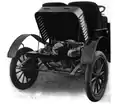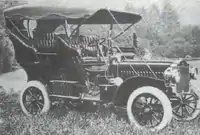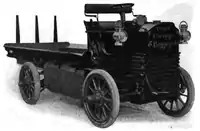Lambert (automobile)
The Lambert automobile and Lambert truck were built by the Lambert Automobile Company as an American vehicle from 1905 through 1916.[1] The Lambert automobile motor in the early part of manufacturing moved around on the chassis. It was on the back of the chassis, then in the center, then to the front, and back again to the rear of the automobile. The early motors were built at the Lambert factories of the Buckeye Manufacturing Company and later they were outsourced to other proprietary manufactures.[2]

Chassis and suspension
The Lambert chassis of the high end employed a three-point suspension to save driving power by decreasing the lift required of the automobile body because of road surface variations. It saved wear and tear on the automobile body and its parts. The others used ordinary suspension.[3] Sometimes a shaft drive was provided on some models, however most Lambert automobile models were with a chain drive to the rear axle.[2]
Powertrain
The Lambert automobile chassis with the gearless friction drive speed change transmission was the basis for the Lambert automobiles and trucks built from 1906 through 1916. The valve action of the engines were hardened steel cams that were applied to the cam shaft. The cam faces were slightly convex, and worked on hardened rollers, carried in swinging forks, which bore against square ended sliders. The valves were aluminum heads driven to shoulder on riveted steel stems. The valve action was direct with no side action on the sliders. The compression was between 50 and 55 pounds of pressure.[4]
The Lambert opposed cylinder motor had a number of features not usual in that form of gas engine in that era. For example, the oiler was of the precision variety, in which a ratchet actuated worm drive a worm gear carrying a spring actuated oil force pump successively over the oil leads to be supplied, the plunge spring being compressed by a circle of wedges, and the rise from each compression being regulated by an individual temper screw. Oil leads dropped oil on the crank wrist rod ends. The cranks had full disk arms and the crank shaft journals ran in bronze bearings.[4]
Racing success
Lambert came in second in an automobile race conducted in July 1905 from Chicago to St. Paul. There were a total of 53 automobiles entered into the race and Lambert's was the only gasoline powered automobile to finish. The success of Lambert's 16 horsepower (12 kW) automobile against others of 40 horsepower (30 kW) was attributed to the Lambert friction gearing disk drive transmission.[5] Some of the models of the Lambert automobiles and trucks are described below.
Lambert automobiles
1906 Model 4

The 1906 Lambert model 4 came with a detachable tonneau. It was a 5-passenger automobile. The wheelbase was 94 inches (2,400 mm), gauge 56 inches (1,400 mm). The wheels were 30 inches (760 mm) by 3.5 inches (89 mm). It weighed 2000 pounds and cost $1050 (equivalent to $29,900 in 2019),[6] including two oil lamps, mats, horn, and tools. The motor was a pair of opposed cylinders 6X4, set far to the front of the vehicle. It came with a friction drive, side chains to the rear wheels.[7]
1906 Model 5

The 1906 Lambert model 5 came with a detachable tonneau. It was a 5-passenger automobile. The wheelbase was 94 inches (2,400 mm), gauge 56 inches (1,400 mm). The wheels were 30 inches (760 mm) by 3.5 inches (89 mm). It weighed 2100 pounds and cost $1200, including two oil lamps, mats, horn, and tools. The motor was a pair of opposed cylinders 6X4, set far to the front of the vehicle. It came with a friction drive, side chains to the rear wheels.[8]
1906 Model 7

The 1906 Lambert model 7 was a side entrance touring automobile. It was a 5-passenger automobile. The wheelbase was 94 inches (2,400 mm), gauge 56 inches (1,400 mm). The wheels were 30 inches (760 mm) by 3.5 inches (89 mm). It weighed 2250 pounds and cost $2000, including five oil lamps, mats, horn, and full tool equipment. The motor was a pair of opposed cylinders 6 X 4 inches (100 mm), set far to the front of the vehicle. It came with a friction drive, side chains to the rear wheels. It had the same body as the Model 6 and was designed for extended traveling.[8]
1906 Model 8

The 1906 Lambert model 8 was a side entrance touring automobile. It was a 5-passenger automobile. The wheelbase was 98 inches (2,500 mm), gauge 56 inches (1,400 mm). The wheels were 34 inches (860 mm) by 4.5 inches (110 mm). It weighed 2300 pounds and cost $3000, including five oil lamps, mats, horn, generator, Jones Speedometer, and full tool equipment. The motor was four 4-cycle water-cooled vertical cylinders, tandem 4.5 X 5 inches (130 mm) with a friction disk drive, side chains to the rear wheels. Side doors to tonneau and side doors to driver's seat. It was designed for extended traveling.[1]
1906 Model A runabout
 1906 Lambert model A runabout
1906 Lambert model A runabout 1906 Lambert runabout rear
1906 Lambert runabout rear 1906 Lambert runabout chassis
1906 Lambert runabout chassis
The 1906 Lambert model A runabout came with a wheelbase of 78 inches (2,000 mm), gauge 56 inches (1,400 mm). It was a 2-passenger automobile. The wheels were 30 inches (760 mm) in diameter by 3.5 inches (89 mm) wide. It weighed 1800 pounds and cost $900, including two oil lamps, mats, horn, and tools. The motor was a pair of opposed cylinders 6 X 4, set over the rear axle of the vehicle. It came with a friction disk drive, side chains to the rear wheels.[7]
Lambert Model A runabout with the chassis side shown. The motor can be seen placed in the rear with the engine cover raised. This is the lowest cost of the Lambert automobiles. This is done by placing the motor with a pair of opposed cylinders in the rear. It is also the most accessible motor location and also places the most weight on the drivers of the wheels. It is therefore an extremely suitable frame for a light low-priced automobile. This was the smallest, lightest and lowest priced 1906 model.[7]
1907 Model F

The 1907 Lambert model F was a side entrance touring automobile. It was a 5-passenger automobile. The wheelbase was 106 inches (2,700 mm), gauge 56 inches (1,400 mm). The wheels were 34 inches (860 mm) by 4.5 inches (110 mm). It weighed 2900 pounds and cost $3000, including five oil lamps, mats, horn, generator, Jones Speedometer, and full tool equipment. The motor was four 4-cycle water-cooled vertical cylinders, 40 horsepower (30 kW), tandem 4.5 X 5 inches (130 mm) with a friction disk drive, side chains to the rear wheels. Side doors to tonneau and side doors to driver's seat. It was designed for extended traveling.[9]
1908 Model 18 runabout

The 1908 Lambert model 18 runabout came with a wheelbase of 95 inches (2,400 mm), gauge 56 inches (1,400 mm). It was a 2-passenger automobile. The wheels were 30 inches (760 mm) in diameter by 3.5 inches (89 mm) wide. It weighed 2300 pounds and cost $800, including two oil lamps, mats, horn, and tools. The motor was a pair of opposed cylinders 6 X 4, set over the rear axle of the vehicle. It came with a friction disk drive, side chains to the rear wheels.[9]
1909 Model 30

The 1909 Lambert model 30 automobile came with a detachable tonneau. It was a 5-passenger automobile. The wheelbase was 110 inches (2,800 mm), gauge 56 inches (1,400 mm). The wheels were 34 inches (860 mm) by 4.5 inches (110 mm). It weighed 2900 pounds and cost $1250, including two oil lamps, mats, horn, and tools. The motor was a 4-cycle 28 horsepower (21 kW) engine set in the front of the vehicle. It came with a friction drive, side chains to the rear wheels.[9]
1910 Model 36

The 1910 Lambert model 36 touring automobile came with a detachable tonneau. It was a 5-passenger automobile. The wheelbase was 110 inches (2,800 mm), gauge 56 inches (1,400 mm). The wheels were 30 inches (760 mm) by 3.5 inches (89 mm). It weighed 2400 pounds and cost $1275, including two oil lamps, mats, horn, and tools. The motor was a 4-cycle 35 horsepower (26 kW) engine set in the front of the vehicle. It came with a friction drive, side chains to the rear wheels.[9]
1912 Model 99

The 1912 Lambert model 99 roadster automobile was a 2-passenger automobile. The wheelbase was 117 inches (3,000 mm), gauge 56 inches (1,400 mm). The wheels were 34 inches (860 mm) by 4.5 inches (110 mm). It weighed 3200 pounds and cost $1250, including two oil lamps, mats, horn, and tools. The motor was a 4-cycle 40 horsepower (30 kW) engine set in the front of the vehicle. It came with a friction drive, side chains to the rear wheels.[10]
1914 Model 46-C

The 1914 Lambert model 46-C touring automobile was a 5-passenger automobile. The wheelbase was 112 inches (2,800 mm), gauge 56 inches (1,400 mm). The wheels were 30 inches (760 mm) by 3.5 inches (89 mm). It weighed 2500 pounds and cost $1200, including two oil lamps, mats, horn, and tools. The motor was a 4-cycle 23 horsepower (17 kW) engine set in the front of the vehicle. It came with a friction drive, side chains to the rear wheels.[10]
1915 Model 48-C

The 1915 Lambert model 48-C touring automobile was a 5-passenger automobile. The wheelbase was 112 inches (2,800 mm), gauge 56 inches (1,400 mm). The wheels were 30 inches (760 mm) by 3.5 inches (89 mm). It weighed 2500 pounds and cost $1200, including two oil lamps, mats, horn, and tools. The motor was a 4-cycle 23 horsepower (17 kW) engine set in the front of the vehicle. It came with a friction drive, side chains to the rear wheels.[10]
Lambert trucks
Model A

Model A truck came with a wheelbase of 96 inches (2,400 mm), gauge 56 inches (1,400 mm). It was a 2-passenger truck. The rear Firestone wheels were 32 inches (810 mm) in diameter by 4 inches (100 mm) wide. The front Firestone wheels were 32 inches (810 mm) in diameter by 3.5 inches (89 mm) wide. The motor was a pair of opposed cylinders 5.5X6 set in rear of driver's seat of the vehicle. It came with a friction disk drive, side chains to the rear wheels. It weighed 3000 pounds and had a pay load capacity of 3000 pounds. It cost $2000. A truck platform and a driver's hood was an extra option.[4]
Model B
Model B truck weighed 2400 pounds and had a 1500-pound payload capacity. It cost $1500. The motor was a pair of opposed cylinders 6X4.5 set in rear of driver's seat of the vehicle. It came with a friction disk drive, side chains to the rear wheels. Model B Truck came with a wheelbase of 96 inches (2,400 mm), gauge 56 inches (1,400 mm). It was a 2-passenger truck. The rear Firestone wheels were 32 inches (810 mm) in diameter by 4 inches (100 mm) wide. The front Firestone wheels were 32 inches (810 mm) in diameter by 3.5 inches (89 mm) wide. A truck platform and a driver's hood was an extra option.[4]
See also
| Wikimedia Commons has media related to Lambert Automobile Company vehicles. |
Footnotes
- Dolnar, p. 225
- Kimes, p. 835
- Dolnar, p. 228
- Dolnar, p. 226a
- Anderson Morning Herald, July 6th, 1905, p. 1
- Federal Reserve Bank of Minneapolis. "Consumer Price Index (estimate) 1800–". Retrieved January 1, 2020.
- Dolnar, p. 226
- Dolnar, p. 225a
- Kimes, p. 836
- Kimes, p. 837
Primary sources
- Anderson Morning Herald archives, Anderson, Indiana
- Biography of John W. Lambert, written by his son January 25, 1935 - obtained from the Detroit Public Library, National Automotive History Collection
- Dolnar, Hugh, Automobile Trade Journal, article: The Lambert, 1906 Line of Automobiles, Chilton Company, v.10 January 1906
- Forkner, John L., History of Madison County, Indiana, New York and Chicago, The Lewis Publishing Company, 1914
- The Horseless Age: The Automobile Trade Magazine, The Horseless Age Company, 1902
Secondary sources
- Bailey, L. Scott, Historic Discovery: 1891 Lambert, New Claim for America's First Car, Antique Automobile magazine, Vol. 24, No. 5, Oct–Nov 1960
- David Burgess Wise, The New Illustrated Encyclopedia of Automobiles ISBN 0-7858-1106-0
- Dittlinger, Esther et al., Anderson: A Pictorial History, G. Bradley Publishing, 1990, ISBN 0-943963-16-8
- Georgano, G.N., The Beaulieu Encyclopedia of the Automobile, Taylor & Francis, 2000, ISBN 1-57958-293-1
- Huffman, Wallace Spencer, Indiana's Place in Automobile History in Indiana History Bulletin, vol 44, no. 2, Feb. 1967; Indianapolis, Indiana Historical Bureau
- Huhti, Thomas, The Great Indiana Touring Book: 20 Spectacular Auto Tours, Big Earth Publishing, 2002, ISBN 1-931599-09-2
- James, Wanda, Driving from Japan, McFarland, 2005, ISBN 0-7864-1734-X
- Kimes, Beverly Rae, Standard Catalog of American Cars, 1805–1942, Krause Publications, 1996, ISBN 0-87341-428-4
- Madden, W. C., Haynes-Apperson and America's First Practical Automobile: A History, McFarland, 2003, ISBN 0-7864-1397-2
- Scharchburg, Richard P., Carriages Without Horses: J. Frank Duryea and the Birth of the American Automobile Industry, SAE, 1993, ISBN 1-56091-380-0